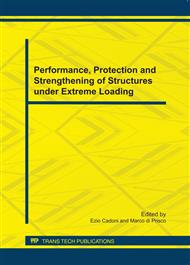p.479
p.485
p.491
p.497
p.503
p.509
p.515
p.521
p.527
Soft Projectile Impacts on Thin Reinforced Concrete Slabs: Tests, Modelling and Simulations
Abstract:
Numerical simulations of reinforced concrete structures subjected to high velocity impacts and explosions remain a difficult task today. Since ten years and more now, the CEA-Gramat has maintained a continuous research effort with the help of different French universities in order to overcome encountered difficulties in modelling the behaviour of concrete structures under severe loading. These difficulties are related to numerical aspects (convergence difficulties of the non linear stress strain relation in 3D configuration, efficiency of the numerical procedure and robustness), but also due to the ability of the material model to simulate the accurately behaviour of a very complex and heterogeneous material like concrete. A new concrete model, named PRM model, has been developed at CEA-Gramat (Pontiroli, Rouquand & Mazars, [1], [2], [3]) to predict the concrete response under a large range of dynamic loadings.
Info:
Periodical:
Pages:
503-508
Citation:
Online since:
July 2011
Authors:
Keywords:
Price:
Сopyright:
© 2011 Trans Tech Publications Ltd. All Rights Reserved
Share:
Citation:


